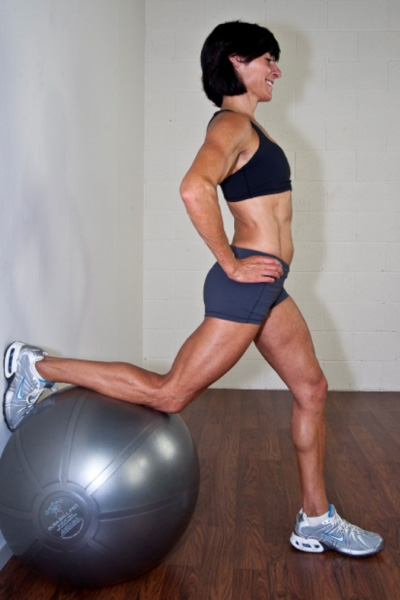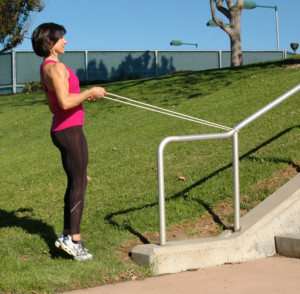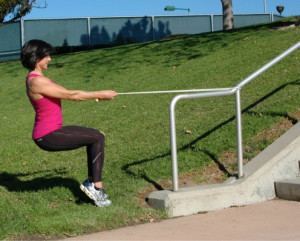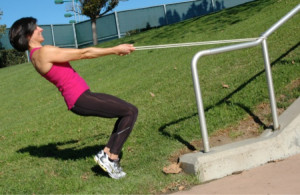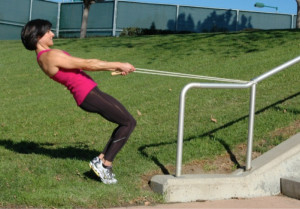When exercising the legs to keep them strong for scuba diving it is important to develop muscle strength, endurance and flexibility. The legs must be versatile for diving activities which place unique demands on the body. During this leg workout divers will benefit from imagining themselves: safely rising from a seated position under the weight of gear; climbing boat ladders; traversing uneven shore terrain; turtling distances on the surface, moving against and across currents; kicking into high gear in an emergency; positioning the body for underwater photography; maintaining overall self-control preventing collisions with reefs and other divers with efficient fin-kick swimming.
————————————————————————————————
Words and Photos by Gretchen M. Ashton, CFT, SFT, SFN, NBFE
————————————————————————————————
Divers also need to be particularly aware of balanced leg strength to maximize equipment design. The most ideal set of fins will function better with good muscle balance and biomechanics of the legs. The focus of this fitness for diving workout is training the muscles of the legs, for strength, endurance and flexibility to aid in proper function of the hip and knee joints.
Body Mechanics
Most leg exercises train more than one muscle group with each movement. Without getting overly complicated, a close stance targets the outer thigh (abductors), but in the same position simply pressing the thighs together as if squeezing a ball between the knees focuses on the inner thigh (adductors). A wide stance targets the inner thigh (adductors), yet in the same position pressing away from the center of the body against resistance targets the outer thigh (abductors). Squats target the front upper thigh while leg extensions target the front lower thigh (quadriceps). The quadriceps muscles extend the knee joint so resistance against extension of the knee joint trains the front of the thigh (quadriceps). The hamstring muscles flex the knee joint so resistance during flexion of the knee trains the back of the thigh (hamstrings). These muscles of the upper leg also act on the hip joint. In the lower leg the calf muscles assist forward movement when walking and fin-kick swimming.
Leg strength and endurance may also be developed with many forms of aerobic exercise such as walking, running, jumping rope, cycling, group exercise classes, dancing, hiking, swimming, and sports activities. Leg muscle imbalance can affect gait, foot, hip and back comfort when performing aerobic activities possibly leading to injuries, pain and interruption of exercise programs.
Stretching is important for flexibility and muscle balance. For example, tight hamstrings often lead to low back complications and pain, and tight quadriceps may pull the knee cap (patella) out of alignment. A few minutes of stretching every morning will make a noticeable difference in how divers feel and move. Stretching is best performed after a warm-up or a hot shower.
Location
The featured exercises are performed outside in a local park but with a bit of ingenuity the workout can be completed at a fitness facility or other indoor location. Some gyms have Sissy Squat apparatus that divers can lock their feet into instead of holding a rope or strap.
Equipment
All that is needed for this workout is a good pair of athletic shoes, a strong cotton jump rope or strap, a dumbbell, and a set of stairs or curb (preferably with a railing). A sturdy tree trunk works well in lieu of a railing and a large rock might even do the trick instead of a dumbbell. It is not recommended to use exercise cables or jump ropes that stretch, diving weights that contain lead, or scuba tanks that lack good hand holds. It is also very important to hold the rope or strap not just the handles.
Breathing
For all of the exercises in this workout inhale through the nose before starting the exercise and during the downward motion; exhale through the mouth during the upward motion (during exertion). If additional breathes are needed during hold positions, work to keep the rhythm and timing of the additional breathes in sequence with the exercise.
Form
Distribute body weight evenly throughout the muscles of the lower body and keep the abdominal muscles contracted during all exercises.
Repetitions
Perform as many repetitions of each exercise as possible in one minute. Repeat the entire sequence one to four times.
Exercise: Sissy Squat – Close Stance
Wrap a non-stretch rope or strap around a railing, pole or tree as shown. With feet in a close stance, rise as high as possible onto the toes. Lean back slightly and use the rope to suspend the position. Sit back into a squat as if reaching for a chair that is just a bit too far behind. Establish a position of right angles at the knees and hips.
Hold this position for 3 to 5 seconds, return to the starting position and repeat. For more challenge continue to lean back and press the hips upward by squeezing the glutes. Be sure to maintain the 90 degree angle at the knees. Progress over a period of weeks from beginner to advanced.
Exercise Wide Stance Squat
Establish a wide stance as shown. Look down each leg to make sure that the hip, knee and toe are aligned. Hold a dumbbell or other weighted object in front of the hips with elbows slightly bent. Sit back and down reaching for that chair or bench that is too far behind.
 Above: Wide Stance Squats starting and squat positions
Above: Wide Stance Squats starting and squat positions
Once in the seated position, the knee, hip and ankle joints are to be as as close as possible to right angles. At the bottom of the squat, squeeze the glutes (buttocks) to reverse the direction of the squat. Note: Do not lock out the knees at the top of the range of motion. Always look up (never look down) when performing a squat.
Exercise: Step Down
Stand sideways with one foot on a step or platform and the other foot suspended at the same height alongside as shown. Hold a railing or carefully balance while bending the knee of the supported leg and lowering the suspended foot toward the ground.
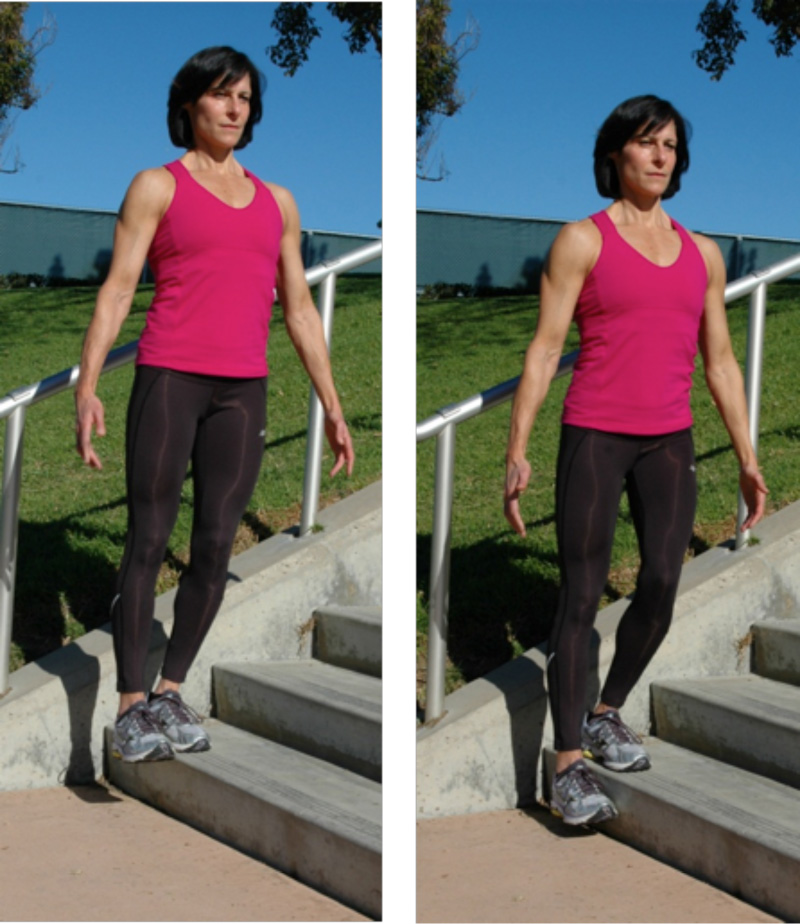
Above: Step down starting and step positions
Hover for a few seconds in the lower position before contracting the glutes and leg muscles straightening the supported leg and returning to the starting position. In the lower position the knee of the supported leg may be over the toes. If there is any pressure through the knee or the knee moves well beyond the toes, stop the exercise and reposition the supported foot in a more forward position in relation to the body. Make sure to move the buttocks out behind the body slightly when bending the knee to help with proper form.
Exercise: Calf Raise
Finish the workout with calf raises. Position a single foot with the heel off of a step or platform as shown. Press on the toes, contract the glutes and raise the heel high above the toe to contract the muscles of the calf. With control, lower the heel and repeat. Bend the knee of the working leg slightly, hold a railing if needed for balance, and pause at the top for a few seconds to maximize the exercise.
Words & Photos by Gretchen Ashton
Gretchen M. Ashton, CFT, SFT, SFN, NBFE, is registered with the National Board of Fitness Examiners, and is an International Sports Sciences Association Elite Trainer; personal trainer, specialist in fitness therapy, specialist in fitness nutrition, and a world champion athlete. Gretchen is founder of ScubaFit LLC, developed the Comprehensive FitDiver®program, is an advanced scuba diver, nitrox diver, and co-author of the ScubaFit® Diver Course. She is an Expert Speaker for Los Angeles County Scuba Advanced Diver Program and Underwater Instructor Certification Course.
Gretchen publishes FitDiver® Magazine, is Fitness Editor and/or contributor for California Diver Magazine, DiverWire, X-Ray Mag, and Scuba Sport Magazine, has been published in Alert Diver United States and Asia-Pacific, at Divetime.com, is an author at ScubaBoard, and a Scuba Fitness Examiner at Examiner.com. Gretchen has appeared on Scuba Radio and Dive Zone Radio, presented at the Scuba Show, has been a guest at dive medicine conferences, was featured in the President’s Council of Physical Fitness and Sports newsletter for inspiring and innovative accomplishments in fitness, and in the Margaritaville Key West website culinary column. As an athlete she set 21 World and Americans records and is the second woman inducted into the AAU Power Lifting Hall of Fame.

